Human Flower Project
The Gift of an Orange
Brighter than gold, juicier than frankincense, sweeter than myrrh—and packed with wondrous information.

Feed the mind and spirit with something ripe and real
Photo: John Groome
By James H. Wandersee and Renee M. Clary
EarthScholars™ Research Group
Our grandparents told us that when they were children, they cherished receiving oranges as a special Christmas gift. We probably looked puzzled and utterly grateful that we would be receiving much more than that. Yet, each year they made sure that we would also find oranges in our own Christmas stockings. The orange was an object-lesson – one that took hold for both of us.
Today, we make sure there is a bowl with polished oranges on the dining room table to grace our families’ Christmas celebrations, reminding us that a Christmas gift does not have to be battery-powered and expensive to be beautiful and memorable. Oranges also demonstrate that all life on Earth depends on plants, and that plants are more important for our happiness and survival than anything humans make. For our own families, the gift of an orange is a tradition we hope to continue across many Christmases yet to come.
In the 21st century, the experience of smelling and tasting a sweet and juicy orange on a cold winter’s day may not seem as amazing to children as it once was “back in the day.” Still, we know that without thoughtful and intentional, perspective-altering lessons from their elders, children may lose their natural sense of wonder.
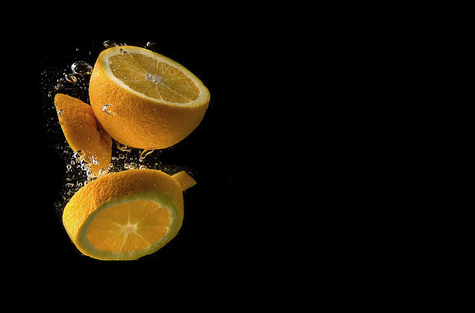
Three orange
Photo: Chris Harvey
If they do become jaded, indoor-dwelling, technology-driven, processed-food-valuing, nature-detached consumers, then it is we adults who are to blame.
Anthropologist Rachel Frisk (2000) writes, “In most cultures, the elderly are responsible for passing down oral traditions and teaching and instructing younger members. By telling stories, myths, legends, and singing songs, the elderly keep their heritage and history alive. Teaching younger members skills and subsistence knowledge is also very important for the existence of a culture…Frequently, groups will depend on their elders to give them traditional answers to survival challenges and teach them local ecology.”
If you have not already established a plant-mentoring relationship with a child, consider using our brief object lesson: with your help, a young person can discover that an orange is a fascinating natural gift which appreciates in value to you as you learn more about it.
Begin with two oranges—a navel orange, plus either a Valencia orange or a blood orange that you’ve purchased recently from a grocery store or fruit market. Give the child the two oranges to hold and to observe. You will also need a sheet of drawing paper and a black marker, a print-out of this lesson, plus a safe, plastic-dinnerware knife with a serrated edge. Now, the fun begins….
Q. 1. Are your two oranges still alive? How can you tell?
A. Yes, each was alive during all of the time that they were growing on orange trees and they will stay alive for an interval of 1 week to 1 month after they’re picked (depending upon storage temperature: refrigeration extends their shelf life). While they are still alive, you should eat them, cook with them, dry them in a food dehydrator, or can them.
What do we mean by saying an orange is alive? We mean that many of the metabolic processes of life inside the orange’s cells are continuing, and that the orange is still breaking down available nutrients (undergoing respiration) to release energy that sustains its life. The seeds inside the fruit are also alive. It is hard to ascertain all this without special scientific equipment and chemicals. However, you will know that an orange is no longer alive if it does not look and smell edible.
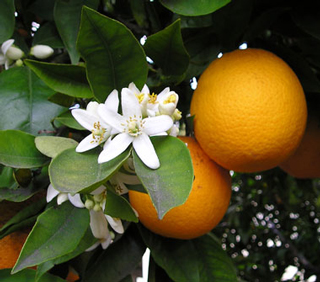 Orange tree in bloom
Orange tree in bloom
Photo: State Symbols USA
Q. 2. How are the sweet-smelling orange blossoms (white flowers) that we see on this color image of an orange tree related to how oranges develop?
A. The orange has become the most commonly grown tree fruit in the world. All oranges begin as orange blossoms which are the tree’s flowers. No flowers, no oranges! Look at the oranges that you have. Can you tell which pole of each orange was attached to the tree? The clue will be a green and/or star-shaped stem-end. Can you tell which pole of your oranges is where the flower was attached? The clue will be a small, sunken, “belly-button-like” area or hole.
Most oranges are bee-pollinated, but navel oranges develop into ripe fruit without the need for pollination—which is very unusual! How can that be? All of the world’s navel oranges come from one strange orange blossom bud cut from a single mutant, seedless orange tree that appeared on a plantation in Bahia, Brazil in 1820. In nature, a mutant tree that produced seedless fruit would simply die out, but the Brazilian orange growers thought that seedless oranges would be easier for their customers to eat, so they grafted that one odd bud onto another orange tree, then they grafted seedless buds from that tree onto another, and so on—until now we have lots of navel orange trees producing seedless oranges. Note that seedless orange trees are not self-sustaining; they would die out without continual human intervention.
 Tapestry pillow based on orange design by William Morris
Tapestry pillow based on orange design by William Morris
Photo: English Heritage
Q. 3. What are the age possibilities for the trees that produced your two oranges? How many years does an orange tree keep on bearing fruit?
A. If a hybrid orange tree starts bearing fruit at age 5, by age 40 some orange growers consider it to be ready for removal and replanting. However, orange trees can actually continue to yield fruit for 100 years or more. Once it starts producing oranges, a tree will yield between 100 to 300 oranges per growing season for many decades.
Q. 4. Imagine yourself standing in an orange grove, facing an orange tree full of oranges. Draw the shape of such an orange tree and then use labeled arrows to predict where on the tree you would be able to pick the best fruit.
A. Plant science researchers who have studied many orange trees tell us that the following locations on an orange tree are the best for picking oranges: (a) the south side of the tree has the sweetest oranges, while the oranges on the north side are least sweet—with the east and west sides yielding moderately sweet ones; (b) the same directional pattern is true for the oranges having the most juice and the least; (c) the same directional pattern is true for oranges with the most vitamin C and the least; and (d) the sweeter oranges grow at the top of the tree, as compared to the low-hanging fruit that you don’t need a ladder to pick. So your “best” arrows should be pointing at the south side and top of your tree-drawing.
Q. 5. Choose and hold one of your oranges in your hand so that the blossom-end faces upward—just as it did when it was growing on the tree. Now show me which parts of this orange you would choose if you wanted to eat only the sweetest part of this orange.
A. Plant science researchers who have studied many oranges tell us this about the sweetness of any orange: If you slice the orange in half along its “equator” (mid-way between its blossom-end and stem-end), the blossom half will be sweeter than the stem half of the orange. Note: If you have several naval oranges, the one with the biggest navel opening will be the sweetest.
Q. 6. Cut your two oranges in half, vertically, from blossom-end downward. Keep the parts of each orange together. Notice there are seeds inside of one of the two oranges—namely in the Valencia orange or in the blood orange—but not inside the naval orange. If you planted some of those orange seeds you saw, would they eventually grow to become orange trees that produced more oranges just like the one you have?
A. Simply put, unlike many other kinds of plants, successfully growing orange trees from seed is a tricky process, Some seedlings never bear fruit, or the seedlings may take an excessive number of years to yield fruit, and even then, you may be disappointed because the oranges you get from such trees may be inedible. However, if you simply would like to watch an orange plant germinate and grow, then planting some orange seeds makes sense.
You should also know that commercial orange growers do not plant seedlings—instead, they plant grafted hybrid trees. Using a sharp knife and budding tape, growers graft a disease-resistant, hardy lemon tree rootstock (root system) to a desirable orange tree scion (a budded branch—also called a budstick—which was cut-off from an already productive orange tree). This “plant merger” works because all citrus plants (lemons, oranges, grapefruit, limes) belong to the same plant genus, and are thus quite closely related. These newly grafted hybrids are cultivated for 1 year before planting them in an orange grove (Florida term) or in an orange orchard (California term). These hybrids also bear fruit quicker—in just 5 years, as opposed to at least 15 years for seedlings!
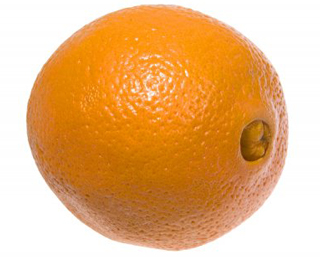 California navel orange within an orange
California navel orange within an orange
Photo: Baldor Food
Q. 7. Examine the blossom end of your sliced naval orange? Can you see what some people call a “baby orange” inside of it, near the “navel” of the orange? What is the explanation for this very surprising “orange inside an orange?”
A.Plant science researchers who have studied naval oranges tell us that the seedless orange is the result of spontaneous change in this fruit tree’s genetic code (a mutation). The same mutation led to the formation of a kind of undeveloped mini- twin orange embedded inside the main orange’s peel. When viewed from the outside of the orange, this smaller, undeveloped twin leaves a human-navel-like concavity (opening) at the blossom-end.
 Ripe green oranges from Thailand
Ripe green oranges from Thailand
Photo: Appon’s Thai Food Recipes
Q. 8. Oranges can be green, red, or orange. What does an orange’s color tell you?
A.Plant scientists have found that growing oranges where there are cold nights with a low temperature of about 40ºF turns the skin color of oranges from green to bright orange. In contrast, oranges grown in hot, tropical Thailand remain green. Some varieties of oranges even have a red-orange skin. In short, the skin (rind) color of oranges tells us nothing about when they are ripe and full of mature juice. They can be green, orange, or red-orange and still be ripe. Some oranges even revert from orange to green color when the growing weather warms up. It is a comfort to know that it is unlawful to sell unripe oranges because, unlike other fruit, oranges do not continue to ripen once they have been picked. So, as a rule, if they are for sale in a grocery store or fruit market, they are ripe.
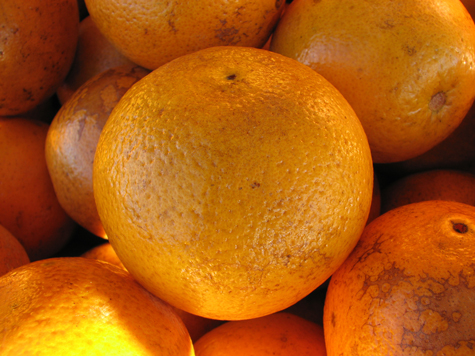
Florida navel oranges
Photo: wiki
Q. 9. The two major US orange-growing states are Florida and California. How might you be able to tell a Florida orange from a California orange?
A. In general, Florida oranges have a thinner skin (rind), higher sugar levels, and more juice than California oranges—making them more desirable for making juice. Note the color of a ripe Florida orange, shown in the photo above.
In contrast, California oranges have a bright and beautiful orange color and have fewer blemishes, for greater presentation-appeal. Thus they are often considered best for use as hand-peeled “eating oranges.”
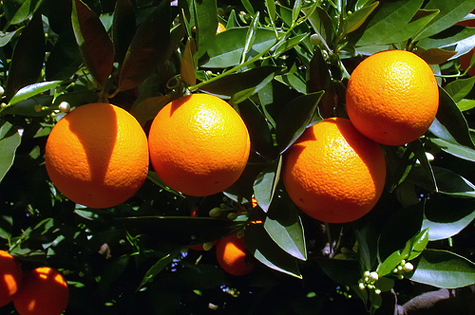
Glamour oranges, from California
Photo: flickr
Quality also depends on the variety of orange and the time of year, as the two states’ orange crops are at their best at different times. Florida navel oranges are best from November to January; Florida Valencia oranges are best from March through May. California navels are market-available from December through May and California Valencias are sold in stores from May through October.
Q. 10. What layers do you expect to find inside an orange? Look and see!
 Orange interiors
Orange interiors
A. Orange fruits have a thick, orange-colored, outside layer called the rind, skin, or peel. The outer-most layer of the rind can be grated to produce orange zest—which is popular in cooking because it contains the oil glands and has a strong flavor similar to the inner fleshy fruit itself.
The side of the rind on the inside of the fruit is a bright white color and is called the pericarp or albedo (al-BEE-dough). There is a thin, white material attached to the inside of the rind that also attaches to the edible fruit-flesh. This thread-like material, part of the pericarp, is known as the pith.
The edible flesh of the orange fruit is divided evenly into pieces called segments or more properly, carpels. Approximately 12 carpels contain fruit pulp and the juice sacs which hold the orange’s juice. These sacs burst and release juice when the orange is squeezed. The carpels also contain the orange’s seeds, known as pips.
Woman releasing juice from an orange’s juice sacs by squeezing
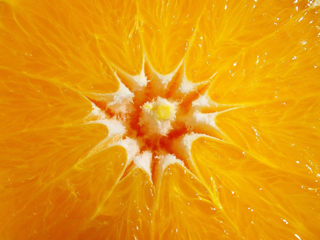 One of the world’s favorite flavors
One of the world’s favorite flavors
Photo: Lebensmittelfotos
Q. 11. What are the world’s favorite food and drink flavors?
A. Although world consensus is difficult to determine, one respectable data set reveals the following : 1. chocolate, 2. vanilla, and 3. orange! Note that all three flavor favorites come to us from plants. Chocolate is produced using the beans from the tropical cacao tree; vanilla is obtained from vanilla orchid seed pods; and orange flavoring comes to us from the fruit of the sweet orange tree.
These questions and answers can be adapted to suit the needs, ability, curiosity, patience-level, and interest of the individual child (or adult). Mentors of course can shorten, paraphrase, or expand upon our answers. We hope this little lesson can serve as the basis of an informal, interactive, teaching conversation you could have about the gift of an orange. Don’t be surprised if your ”student” spontaneously decides to teach others about oranges. A paradoxical aspect of plant knowledge is that you can give it away and still possess it yourself.

